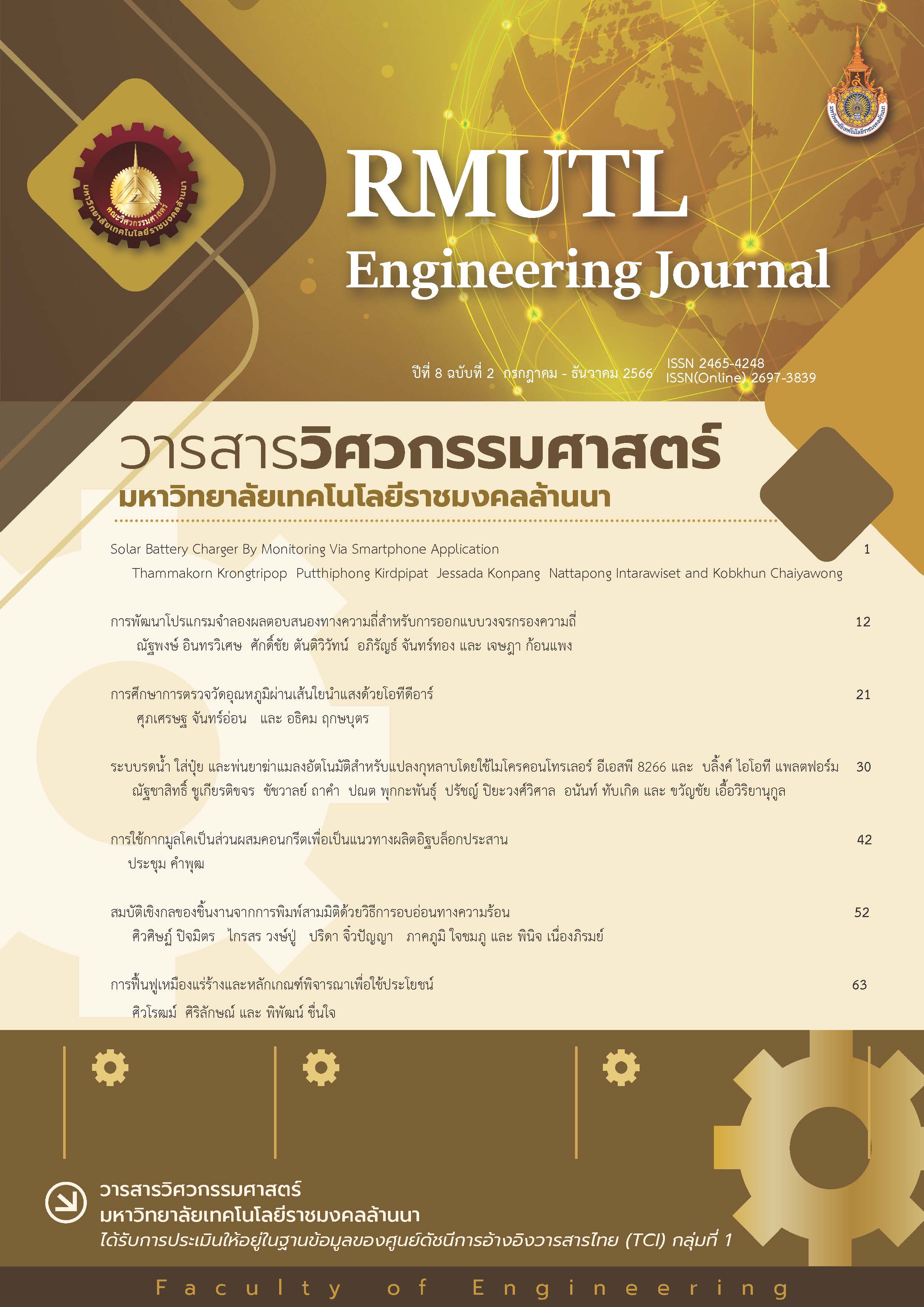Using Cow Feces as a Concrete Mix as a Guideline For the Production of Interlocking Bricks
DOI:
https://doi.org/10.14456/rmutlengj.2023.11Keywords:
Cow Feces, concrete, Dairy Farm, Interlocking BricksAbstract
This research aims to use cow feces from dairy farms as an aggregate of interlocking bricks. The cow feces were obtained from the separator process. The dry cow feces passing sieve No 4 were among the ingredients in concrete which serves as a guideline in producing interlocking bricks as community products. The mixture consisted of concrete and fine sand in a ratio of 1: 7 by volume. Fine sand has been replaced by 0, 0.5, 1, 1.5, 2, 2.5, 3, 3.5, 4, 4.5 and 5 parts of dairy waste, respectively. All the mixing used 350 ml of water. A concrete cube specimen was 10 x 10 x 10 cm in dimension. The moisture content, water absorption, and density were investigated at 28 days. The compression strength was studied at 7, 14, 21 and 28 days. The results showed that the compressive strength and density reduces with increasing cow feces. The moisture content and absorption of the sample tend to increase. The interlocking bricks with size 22.5 x 11.5 x 6 cm were chosen from the concrete mix proportion as fine sand to cow feces waste equals 1: 6.5 : 0.5 The moisture content, water absorption and density of interlocking bricks were also investigated within 28 days. The interlocking brick is in accordance with TCPS 602, and can be used as building materials.
References
Dairy cattle and dairy development strategy subcommittee. Dairy cattle and dairy action plan, Phase 1 (2021-2027). Bureau of Agricultural Economic Research, Department of livestock development; 2021.Thai.
Surtia G, Panchal P, Patel M, Ravikumar RK, Kumar V. Improving livelihood initiatives through environmental friendly solutions derived from livestock by-product. Int. J. Sci. Environ. Technol. 2016;5(2):658-65.
Khamput P. Utilization of coconut shell ash as aggregate in concrete blocks products. Thai Environmental Engineering Journal. 2018;32(1):9-16.Thai.
Charoennatkul C. Interlocking blocks containing oil palm ash and shells waste. Journal of Community Development and Life Quality. 2014;2(1):103-112.Thai.
Kokkamhaeng W, Rattanawong N. Interlocking blocks from kaolin. The 13th National Civil Engineering Conference, 2008 May 14-16; Chonburi; 2008. p. MAT021.Thai.
Hirun Y, Kreepala W, Nokkeaw K. Improving the quality of interlocking blocks made from Sakon Nakhon laterite soil with duck manure. The 16th National Civil Engineering Conference, 2011 May 18-20; Chonburi; 2011. p. MAT032.Thai.
Khamput P, Suweero K, Boksuwan A, Panlai N. The use of volcanic rock dust in interlocking block products. Journal of Community Development and Life Quality. 2015;3(2):239-247.Thai.
Khamput P. Using waste rock of mining andesite for development of interlocking block product. Thai Environmental Engineering Journal. 2017;31(3):13-19.Thai.
Luangsod S, Khamput P, Namarak C, Pradmali S. Community technology for development of interlocking block product from basalt fragments.
Khamput P, Suweero K. Effect on compressive strength of replacing sand by dolomite in concrete. The 10th Eco-Energy and Materials Science and Engineering Symposium, 2012 December 5-8; Sunee Grand Hotel; Ubon-Ratchathani; 2012. p. 88.Thai.
Boksuwan A, Khamput P. Interlocking block product for community enterprises from anhydrite rock fragments. The 3rd National RMUTR Conference, 2018 July 18-20; Rajamangala University of Technology Rattanakosin Wang Klai Kangwon Campus; 2018. p. 19-26.Thai.
Khamput P. A study of compressive strength of quarry dust concrete mixed water reducing and accelerating admixture (W/C = 0.5). Abstract 31st Congress on Science and Technology of Thailand, 2005 October 18-20; Technopolis, Suranaree University of Technology; Nakhon Ratchasima; 2005. P. 313.Thai.
Thai Industrial Standards Institute. TCPS 602-2547. Community product standards on interlocking bricks. Ministry of Industry. Bangkok; 2004.Thai.
Khamput P. Interlocking brick products from hemp core. Annual Concrete Conference 14, 2019 March 6-8; Prachuap Khiri Khan; 2019. p. ENV-008.Thai.
Khamput P. Interlocking block products from tobacco stem waste. National Academic Conference Rangsit University 2019, 2019 May 4; Pathum Thani; 2019. p. 231-240.Thai.
Thai Industrial Standards Institute. TIS.15 part 1-2555. Standard for Portland cement part 1 specification. Ministry of industry. Bangkok; 2012.Thai.
Thai Industrial Standards Institute. TIS.566-2562. Standard for concrete aggregate. Ministry of industry. Bangkok; 2019.Thai.
British Standards Institution. BS 1881 : Part 108. Method for making test cubes from fresh concrete: code of testing concrete part 108. London: BSI; 1983.
Thai Industrial Standards Institute. TIS.109-2517. Standard for sampling and testing concrete masonry unit. Ministry of industry. Bangkok; 1974.Thai.
Thai Industrial Standards Institute. TIS.2601-2556. Standard for cellular lightweight concrete blocks using preformed foam. Ministry of industry. Bangkok; 2013.Thai.
Chindaprasirt P, Jaturapitakkul C. Cement Pozzolanic and concrete 7thedition. Bangkok: Thailand Concrete Association;2012.Thai.
Khamput P, Somna K. Production of cement-bonded fiberboard from oil palm fiber. Thai Environmental Engineering Journal. 2018;32(3):29-34.Thai.
Panlai N, Khamput P, Suweero K. Product of cement-bonded bagasse fiber board. Journal of Innovative Technology Research. 2019;3(2):59-67.Thai.
Khamput P. Hempcrete using cement and gypsum plaster as a binder. Journal of Engineering, RMUTT. 2022;20(1):117-125.Thai.
Khamput P. Hollow Non-load-bearing concrete block products from hemp core. Thailand Research Expo: Symposium 2019 Proceedings, 2019 April 7-10; Central World Bangkok; 2019. p. 434-445.Thai.
Khamput P. Hollow non-load-bearing concrete block products from tobacco stem waste. The 11th Rajamangala University of Technology National Conference. 2019 July 24-26; Chiang Mai; 2019. p. 374-387.Thai.
Pramali S, Khamput P. Developing a white clay concreteblock mixed with the residue of rice and coconut. The 20th National Environment Conference. 2021 May 12-13; Khon Kaen; p. 139-145.Thai.
Downloads
Published
How to Cite
Issue
Section
License

This work is licensed under a Creative Commons Attribution-NonCommercial-NoDerivatives 4.0 International License.










